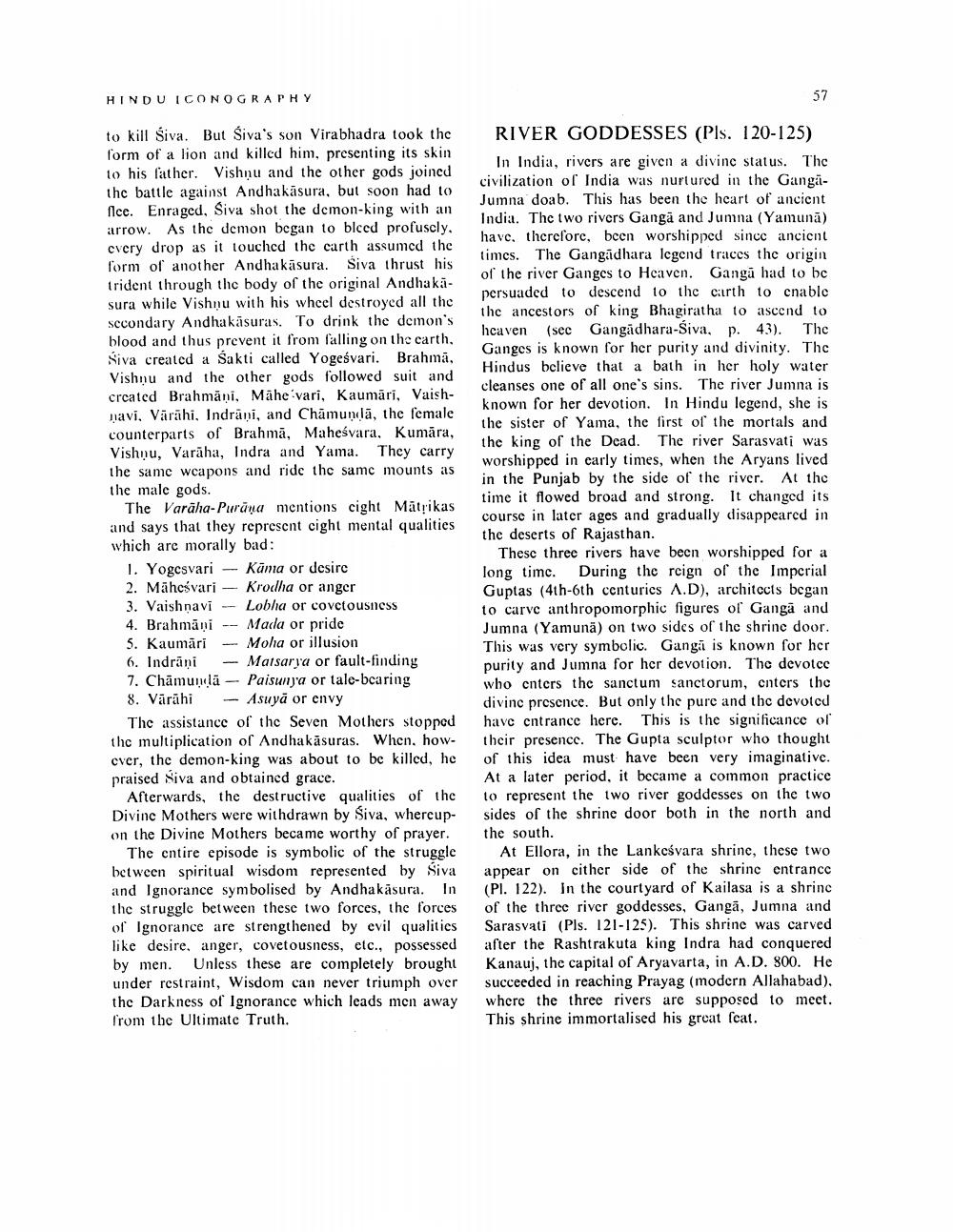________________
HINDU ICONOGRAPHY
to kill Śiva. But Śiva's son Virabhadra took the form of a lion and killed him, presenting its skin to his father. Vishnu and the other gods joined the battle against Andhakasura, but soon had to flce. Enraged, Siva shot the demon-king with an arrow. As the demon began to bleed profusely. every drop as it touched the earth assumed the form of another Andhakasura. Siva thrust his trident through the body of the original Andhakasura while Vishnu with his wheel destroyed all the secondary Andhakāsuras. To drink the demon's blood and thus prevent it from falling on the earth, Siva created a Sakti called Yogeśvari. Brahma, Vishnu and the other gods followed suit and created Brahmani, Mähe vari, Kaumārī, Vaishnavi. Vārāhi, Indrāni, and Chamunda, the female counterparts of Brahma, Maheśvara. Kumāra, Vishnu, Varaha, Indra and Yama. They carry the same weapons and ride the same mounts as the male gods.
The Varaha-Purana mentions cight Matrikas and says that they represent eight mental qualities which are morally bad:
1. Yogesvari
2. Mäheśvari 3. Vaishnavi 4. Brahmāņi
5. Kaumāri
Kāma or desire Krodha or anger Lobha or covetousness Mada or pride Moha or illusion Matsarya or fault-finding Paisunya or tale-bearing
6. Indrāni
7. Chamunda 8. Vārāhi - Asuya or envy
The assistance of the Seven Mothers stopped the multiplication of Andhakasuras. When, however, the demon-king was about to be killed, he praised Siva and obtained grace.
Afterwards, the destructive qualities of the Divine Mothers were withdrawn by SŚiva, whereupon the Divine Mothers became worthy of prayer.
The entire episode is symbolic of the struggle between spiritual wisdom represented by Siva and Ignorance symbolised by Andhakasura. In the struggle between these two forces, the forces of Ignorance are strengthened by evil qualities like desire, anger, covetousness, etc., possessed by men. Unless these are completely brought under restraint, Wisdom can never triumph over the Darkness of Ignorance which leads men away from the Ultimate Truth.
57
RIVER GODDESSES (Pls. 120-125)
In India, rivers are given a divine status. The civilization of India was nurtured in the GangaJumna doab. This has been the heart of ancient India. The two rivers Ganga and Jumna (Yamuna) have, therefore, been worshipped since ancient times. The Gangadhara legend traces the origin of the river Ganges to Heaven. Ganga had to be persuaded to descend to the earth to enable the ancestors of king Bhagiratha to ascend to heaven (see Gangadhara-Śiva, p. 43). The Ganges is known for her purity and divinity. The Hindus believe that a bath in her holy water cleanses one of all one's sins. The river Jumna is known for her devotion. In Hindu legend, she is the sister of Yama, the first of the mortals and the king of the Dead. The river Sarasvati was worshipped in early times, when the Aryans lived in the Punjab by the side of the river. At the time it flowed broad and strong. It changed its course in later ages and gradually disappeared in the deserts of Rajasthan.
These three rivers have been worshipped for a long time. During the reign of the Imperial Guptas (4th-6th centuries A.D), architects began to carve anthropomorphic figures of Ganga and Jumna (Yamuna) on two sides of the shrine door. This was very symbolic. Ganga is known for her purity and Jumna for her devotion. The devotee who enters the sanctum sanctorum, enters the divine presence. But only the pure and the devoted have entrance here. This is the significance of their presence. The Gupta sculptor who thought of this idea must have been very imaginative. At a later period, it became a common practice to represent the two river goddesses on the two sides of the shrine door both in the north and the south.
At Ellora, in the Lankeśvara shrine, these two appear on either side of the shrine entrance (Pl. 122). In the courtyard of Kailasa is a shrine of the three river goddesses, Ganga, Jumna and Sarasvati (Pls. 121-125). This shrine was carved after the Rashtrakuta king Indra had conquered Kanauj, the capital of Aryavarta, in A.D. 800. He succeeded in reaching Prayag (modern Allahabad). where the three rivers are supposed to meet. This shrine immortalised his great feat.




